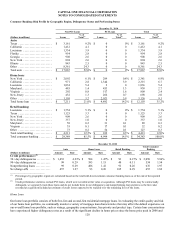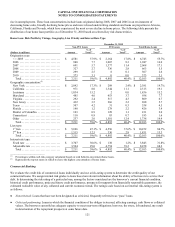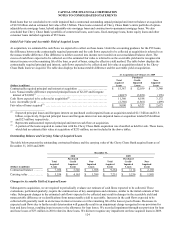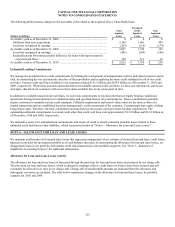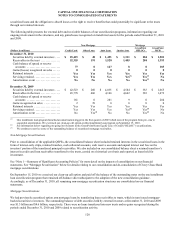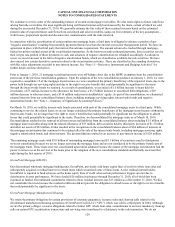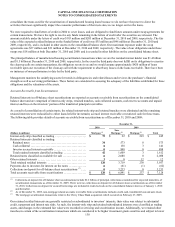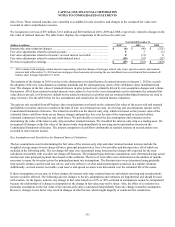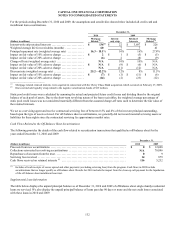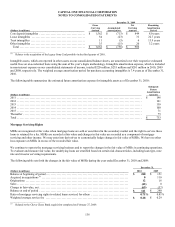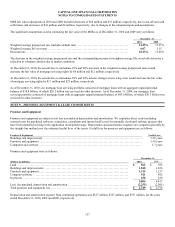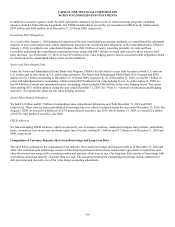Capital One 2010 Annual Report Download - page 150
Download and view the complete annual report
Please find page 150 of the 2010 Capital One annual report below. You can navigate through the pages in the report by either clicking on the pages listed below, or by using the keyword search tool below to find specific information within the annual report.
CAPITAL ONE FINANCIAL CORPORATION
NOTES TO CONSOLIDATED STATEMENTS
130
consolidate the trusts used for the securitization of manufactured housing loans because we do not have the power to direct the
activities that most significantly impact the economic performance of the trusts since we no longer service the loans.
We were required to fund letters of credit in 2004 to cover losses, and are obligated to fund future amounts under swap agreements for
certain transactions. We have the right to receive any funds remaining in the letters of credit after the securities are released. The
amount available under the letters of credit was $183 million and $205 million at December 31, 2010 and 2009, respectively. The fair
value of the expected residual balances on the funded letters of credit was $35 million and $46 million at December 31, 2010 and
2009, respectively, and is included in other assets on the consolidated balance sheet. Our maximum exposure under the swap
agreements was $27 million and $33 million at December 31, 2010 and 2009, respectively. The value of our obligations under these
swaps was $18 million at both December 31, 2010 and 2009, and is recorded in other liabilities on the consolidated balance sheet.
The principal balance of manufactured housing securitization transactions where we are the residual interest holder was $1.4 billion
and $1.5 billion at December 31, 2010 and 2009, respectively. In the event the third party does not fulfill on its obligations to exercise
the clean-up calls on certain transactions, the obligation reverts to us and we would assume approximately $420 million of loans
receivable upon our execution of the clean-up call with the requirement to absorb any losses on the loans receivable. There have been
no instances of non-performance to date by the third party.
Management monitors the underlying assets for trends in delinquencies and related losses and reviews the purchaser’s financial
strength as well as servicing performance. These factors are considered in assessing the adequacy of the liabilities established for these
obligations and the valuations of the assets.
Accounts Receivable from Securitizations
Retained interests in off-balance sheet securitizations are reported as accounts receivable from securitizations on the consolidated
balance sheet and are comprised of interest-only strips, retained tranches, cash collateral accounts, cash reserve accounts and unpaid
interest and fees on the investors’ portion of the transferred principal receivables.
As a result of consolidation of certain trusts, the related interest-only strip and retained tranches were eliminated and the remaining
retained interests were reclassified to either loans held for investment, accrued interest receivable or restricted cash for these trusts.
The following table provides details of accounts receivable from securitizations as of December 31, 2010 and 2009:
December 31,
2010 2009
(Dollars in millions) Mortgage (3) Non-
Mortgage (2) Mortgage (3) Total
Interest-only strip classified as trading ........................
.
$ 75 $ 22 $ 223 $ 245
Retained interests classified as trading:
Retained notes ............................................
.
34 573 0 573
Cash collateral ............................................
.
8 138 3 141
Investor accrued interest receivable .........................
.
0 898 0 898
Total retained interests classified as trading .................
.
42 1,609 3 1,612
Retained notes classified as available for sale ..................
.
0 2,088 0 2,088
Other retained interests ......................................
.
3 0 12 12
Total retained residual interests ..............................
.
120 3,719 238 3,957
Payments due to investors for interest on the notes .............
.
0 (61 ) (1) (62)
Collections on deposit for off-balance sheet securitizations (1) ...
.
0 3,233 0 3,233
Total accounts receivable from securitizations .................
.
$ 120 $ 6,891 $ 237 $ 7,128
________________________
(1) Collections on deposit for off-balance sheet securitizations include $2.2 billion of principal collections accumulated for expected maturities of
securitization transactions as of December 31, 2009. There were no collections on deposit for off-balance sheet securitizations as of December
31, 2010. Collections on deposit for secured borrowings are included in restricted cash on the consolidated balance sheet as of January 1, 2010
and thereafter.
(2) As of December 31, 2009, non-mortgage related accounts receivable from securitizations includes credit card, installment loan and auto trusts.
(3) The mortgage securitization transactions relate to the Chevy Chase Bank acquisition which occurred on February 27, 2009.
Our retained residual interests are generally restricted or subordinated to investors’ interests, their value was subject to substantial
credit, repayment and interest rate risks. As such, the interest-only strip and retained subordinated interests were classified as trading
assets, and changes in the estimated fair value were recorded in servicing and securitization income. Additionally, we retained other
tranches in certain of the securitization transactions which are considered to be higher investment grade securities and subject to lower


